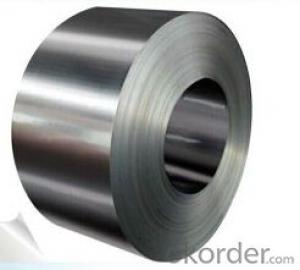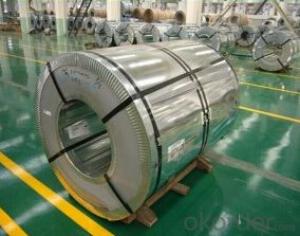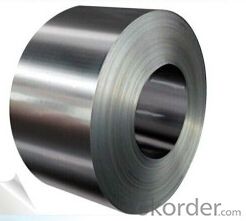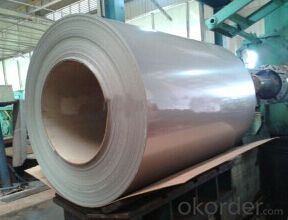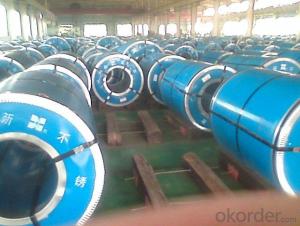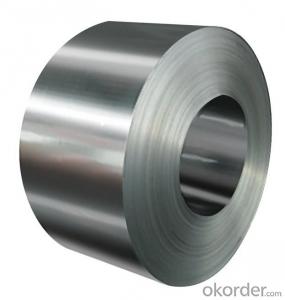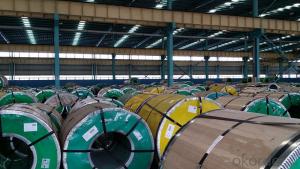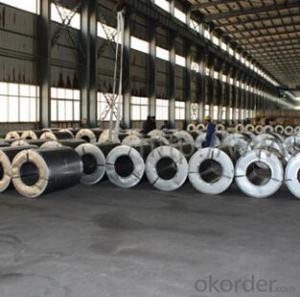304 Cold Rolled Stainless Steel for Buliding Material
- Loading Port:
- Shanghai
- Payment Terms:
- TT OR LC
- Min Order Qty:
- 30 m.t.
- Supply Capability:
- 10000 m.t./month
OKorder Service Pledge
OKorder Financial Service
You Might Also Like
Product Details
Basic Info.
Model NO.:304/304L/316/316L/321/409/409L/410/410S/430
Type:Stainless Steel Strips
Shape:Coil
Grade:300 Series
Certification:ISO, SGS
Perforated:Not Perforated
Standard:ASTM, AISI, GB, JIS, DIN, EN
Technique:Cold Rolled
Surface Treatment:Bright
Surface:2D,2e,2b,2bb,Sb,No.4,Ba,Hl,6k,7k,8k
Width:1000mm/1219mm/1250mm/1500mm/1524mm/1829mm/2000mm
Thinckness:0.3mm to 6mm
Edge:Silt/Mill Edge
Export Markets:Global
Product Description
The detail specification of cold rolled stainless steel coils are as below:
| Grade: | 201/202/301/304/304L/316/316L/317L/321/409/409L/410/410S/430/439 |
| Standard: | ASTM,AISI,JIS,EN,DIN,GB |
| Surface: | 2D,2E,2B,2BB,SB,NO.4,BA,HL,6K,7K,8K |
| Width: | 1000mm/1219mm/1250mm/1500mm/1524mm/1829mm/2000mm |
| Thickness: | 0.3mm to 6mm |
| Edge: | Slit/Mill Edge |
| Origin: | TISCO,POSCO,LISCO,JISCO,BAOSTEEL,Baoxin,Eastern Special Steel and so on |
| Productivity: | 10000MT/Mont |
| MOQ: | 30mont |
| Payment Term: | TT,L/C at sight/, L/C 30,60,90,180 days,WEST UNION |
| Price Term: | FOB/CFR/CIF Ningbo,Shanghai,Tianjin,Shenzhen Port |
| Delivery: | 7-10 days after receive buyer's advance deposit or LC copy |
| Packaging: | Seaworthy Export Standard Package.Products are packed and labeled according to the regulations and customer's requests. Great care is taken to avoid any damage which might otherwise be caused during storage or transportation. In addition, clear labels are tagged on the outside of the packages for easy identification of the product I. D. and quality information. |
| Detail Application: | construction field;ship building industry;petroleum and chemical industries;war and electricity industries;food processing and medical industry; boiler heat exchanger; machinery and hardware industry |
Technical notes:
| Surface Finish Definition | Application | |
| NO.1 | The surface finished by heat treatment and pickling or processes corresponding there to after hot rolling. | Chemical tank, pipe. |
| 2D | Those finished, after cold rolling, by heat treatment, pickling or other equivalent treatment. | Construction Material, heat exchanger,exhaust pipe |
| 2B | Those finished, after cold rolling, by heat treatment, pickling or other equivalent treatment and lastly by cold rolling to given appropriate luster. | Medical equipment, Food industry, Construction material, Kitchen utensils. |
| BA | Those processed with bright heat treatment after cold rolling. | Kitchen utensils, Electric equipment, Building construction. |
| NO.3 | Those finished by polishing with No.100 to No.120 abrasives specified in JIS R6001. | Kitchen utensils, Building construction. |
| NO.4 | Those finished by polishing with No.150 to No.180 abrasives specified in JIS R6001. | Kitchen utensils, Building construction, Medical equipment. |
| HL | Those finished polishing so as to give continuous polishing streaks by using abrasive of suitable grain size. | Building Construction. |
| No.8 | A highly reflective finish obtained by polishing with successively finer abrasive and buffing extensively free of grit lines | Indoor decoration & Reflector, Hospital Equipment |
Our Advantages
All products are made of high-quality imported raw materials.
Excellent shipment after-sales service & Prompt
The Authorized agent of TISCO,JIISCO,the stainless steel distributor of BOSTEEL,ZPSS,LISCO and also can get the resources from all the stainless steel mills in China.
Have own processing and distribution center & can take the orders according to customers' requirements.
The transport in Hangzhou is very convenient & nearby Shanghai and Ningbo Port.
Our products are certified by ISO9001:2008 authentication quality systems.
Quick Response to Your Enquiry.
- Q: How are steel coils used in the manufacturing of household appliances?
- Steel coils are used in the manufacturing of household appliances as a raw material for forming various components such as panels, frames, and structures. The coils are typically cut, shaped, and welded to create the necessary parts used in appliances like refrigerators, stoves, and washing machines. The durability and strength of steel make it an ideal material for ensuring the longevity and performance of these appliances.
- Q: How are steel coils recycled?
- Steel coils are recycled by first being collected and transported to a recycling facility. They are then processed to remove any impurities or contaminants, such as coatings or oils. The coils are then shredded into smaller pieces and melted down in a furnace. The molten steel is then molded into new coils or other steel products, ready to be used again in manufacturing processes.
- Q: I work with stainless steel a lot and I know it's rust resistant but it's definitly not STAIN resistant. You might be able to remove some stains easier from it than you can from some other surfaces but when it does stain, its hard as heck to clean it. It takes forever to scrub stains off my stainless steel pans so maybe it should just be called rustless steel?
- This okorder /
- Q: Im in the process of replacing the gutters/down spouts on my house. The top of the house is four sided. The bottom level has a porch area with 3 sides, two smaller roofs in the back, and one small roof on the side with all stainless steel gutters. A two story house. Not sure of the demensions. They were made at a Steel Mill where the previous owner, worked.This guy wants to buy the stainless gutters but I need to know the market value of this steel and offer him a price. Can someone tell me what I can sell it for? Does it go by the pound? Foot? Can you give me an idea please? Theres a lot of it! I have no clue what to do! Thanks!
- Steel is at an all time high of $3.99 per hundred pounds..Stainless will sell for more....I haulled a pickup truck full 3 days ago and got over a 100 bucks for junk I had laying around the yard.
- Q: Can steel coils be used in the manufacturing of machinery and equipment?
- Yes, steel coils can be used in the manufacturing of machinery and equipment. Steel coils have high strength and durability, making them suitable for various applications in the machinery and equipment industry. They can be shaped, cut, and formed into various components, such as frames, shafts, gears, and structural parts, to meet the specific requirements of different machinery and equipment. Additionally, steel coils can be further processed and treated to enhance their properties, such as through heat treatment or surface coatings, to improve their performance and longevity in the manufacturing process.
- Q: Steel or stainless steel
- Steel often has impurities that can generate fumes, which cause a fever identical to smoke inhalation. You always need to be concerned about what you are breathing around hot metal.
- Q: How are steel coils used in the production of electrical devices?
- Steel coils are an essential component in the production of electrical devices. These coils are typically made from high-quality steel that is precisely wound into a circular shape. They play a crucial role in the functioning of various electrical devices, such as transformers, motors, generators, and inductors. One primary use of steel coils is in transformers. Transformers are vital for stepping up or stepping down voltage levels in electrical circuits. They consist of two separate coils, known as the primary and secondary coils, which are wound around a magnetic core. The steel coil provides stability and support to the windings, ensuring proper alignment and preventing any deformation. Additionally, the high magnetic permeability of steel helps to enhance the efficiency of energy transfer between the coils. In motors and generators, steel coils are employed to create magnetic fields that generate mechanical energy or convert it into electrical energy. The coils are wound around an armature or rotor, which rotates within a magnetic field created by a stator. As the current flows through the coils, a magnetic field is produced, resulting in the rotation of the armature or the generation of electrical power. Inductors, another type of electrical device, also utilize steel coils. An inductor is essentially a coil of wire wound around a core material, often made of steel. Steel coils in inductors help to increase the inductance, which is a measure of the device's ability to store energy in a magnetic field. By storing energy in this manner, inductors can regulate currents, filter out noise, and provide stability to electrical circuits. Overall, steel coils play a vital role in the production of electrical devices by providing stability, support, and enhancing the magnetic properties necessary for their efficient functioning. Without steel coils, the performance and reliability of electrical devices, such as transformers, motors, generators, and inductors, would be significantly compromised.
- Q: How are steel coils used in appliances?
- Steel coils are commonly used in appliances for their strength, durability, and heat conductivity. They are primarily utilized in appliances like refrigerators, air conditioners, and ovens to provide efficient cooling and heating functions. The steel coils act as heat exchangers, transferring thermal energy from one area to another, enabling appliances to control and maintain desired temperatures effectively.
- Q: I have a bottle like this* Can u make hot chocolate in it. Can i heat it.I wanna take hot Chocolate to school
- Stainless Steel Water Can
- Q: How are steel coils used in the production of storage tanks?
- Steel coils are typically used as the raw material in the production of storage tanks. These coils are formed into sheets and then shaped and welded to create the tank's body. The strength and durability of steel make it an ideal choice for storing various substances, including liquids and gases, ensuring the safety and longevity of the storage tanks.
Send your message to us
304 Cold Rolled Stainless Steel for Buliding Material
- Loading Port:
- Shanghai
- Payment Terms:
- TT OR LC
- Min Order Qty:
- 30 m.t.
- Supply Capability:
- 10000 m.t./month
OKorder Service Pledge
OKorder Financial Service
Similar products
Hot products
Hot Searches
Related keywords
